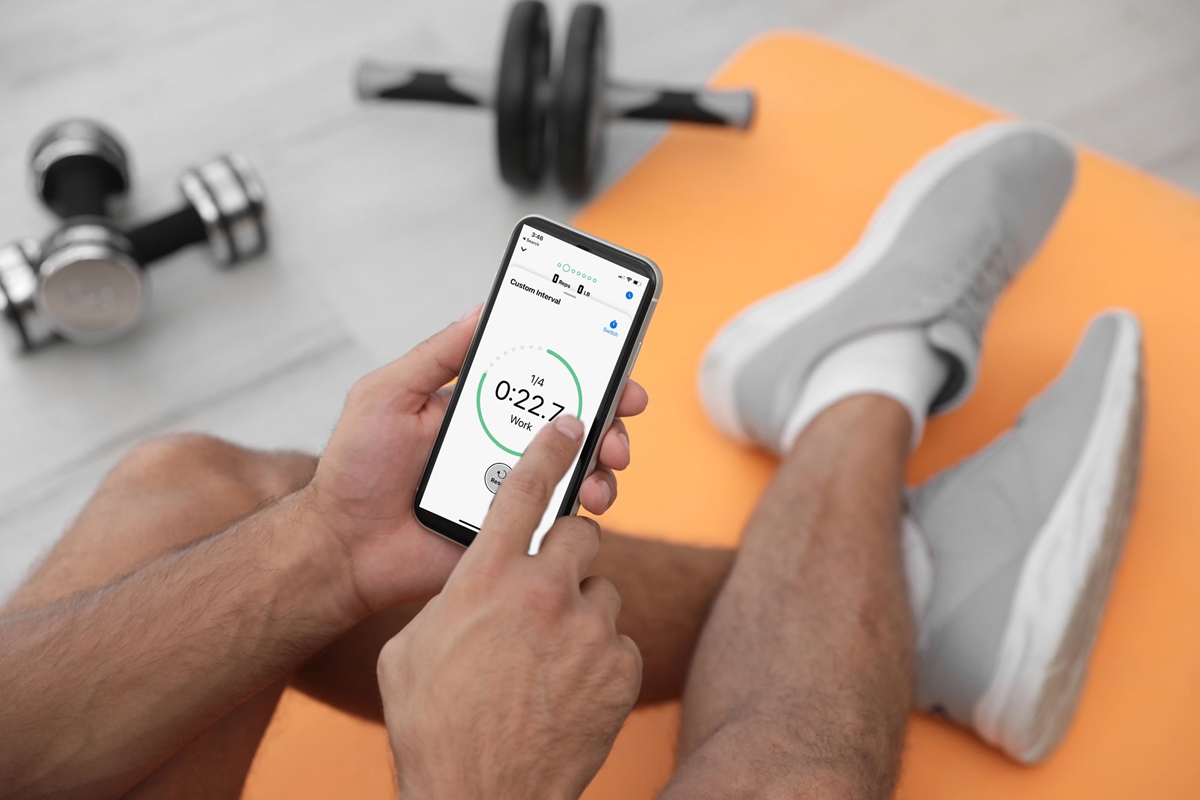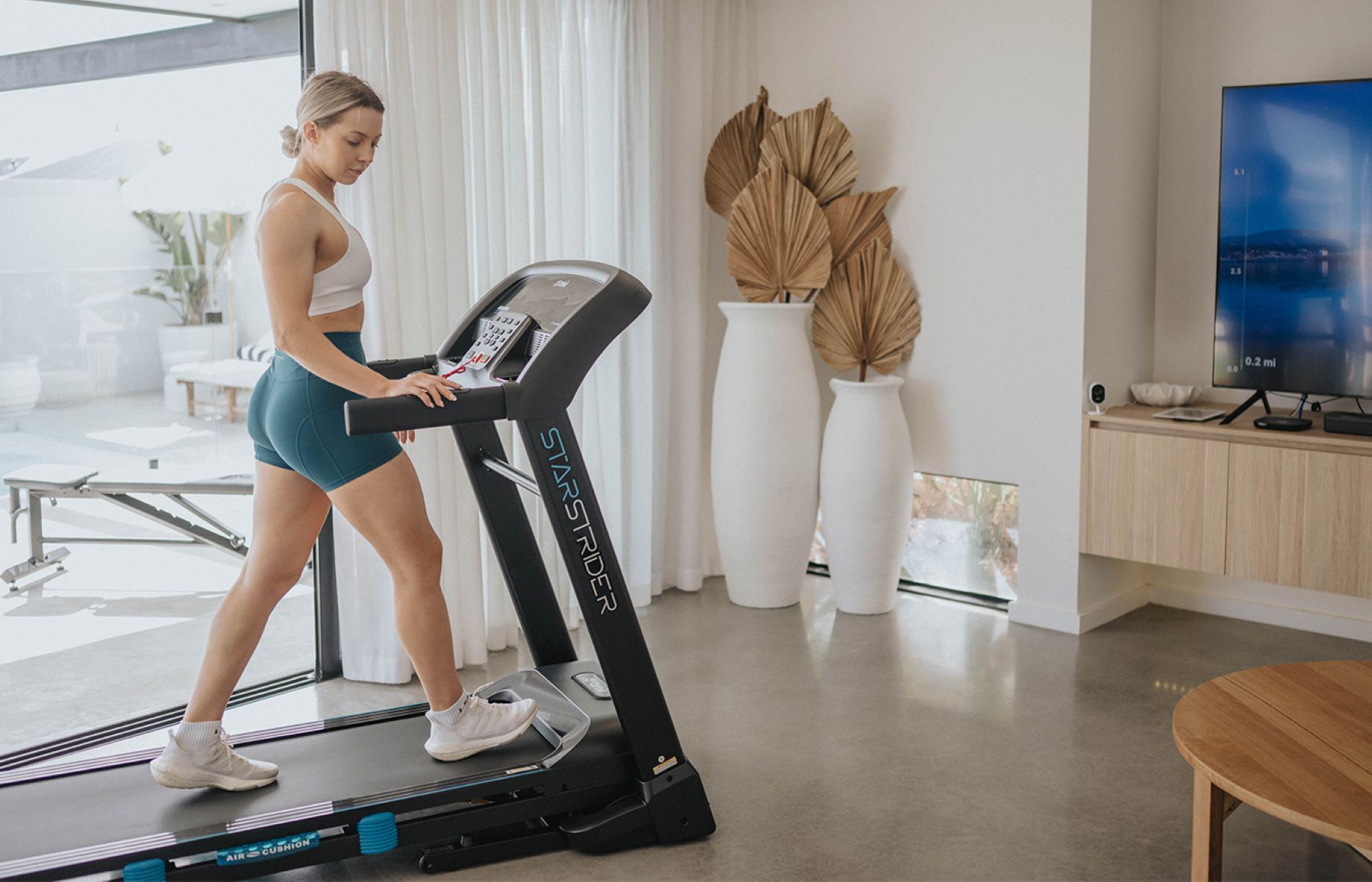

Brands
What Is Interval Training Timer
Modified: March 2, 2024
Discover the top brands for interval training timers and optimize your workouts with precision timing. Boost your fitness with trusted brands in interval training technology.
Introduction
Interval training is a highly effective and popular exercise method that involves alternating periods of high-intensity exercise with periods of rest or lower-intensity activity. It is a great way to maximize your workout in a shorter amount of time, improve cardiovascular fitness, burn calories, and boost overall athletic performance.
But to get the most out of interval training, it is crucial to have a reliable interval training timer. An interval training timer helps you to track and manage your workout intervals, ensuring that you maintain the desired intensity and rest durations. With the help of an interval training timer, you can stay focused, motivated, and achieve your fitness goals effectively.
Whether you are a beginner or an advanced athlete, incorporating an interval training timer into your workouts can take your training to the next level. In this article, we will explore the concept of interval training, its benefits, and discuss the importance of having a reliable interval training timer to optimize your performance.
So, if you are ready to take your fitness routine up a notch, let’s dive into the world of interval training and discover the essential role of interval training timers in achieving your fitness goals.
What is Interval Training?
Interval training is a workout technique that involves alternating between periods of high-intensity exercise and periods of rest or lower-intensity activity. It is a challenging and efficient way to burn calories, improve cardiovascular fitness, and enhance overall athletic performance.
Unlike steady-state cardio exercises, such as jogging or cycling at a consistent pace, interval training pushes your body to its limits and allows you to work at a higher intensity for shorter bursts. The high-intensity intervals are interspersed with recovery periods, which can be active rest or complete rest, depending on your fitness level and goals.
The intensity and duration of the intervals can vary depending on your fitness level and the specific workout routine. For example, a common interval training workout might involve sprinting for 30 seconds and then walking or jogging for 60 seconds. This pattern may be repeated several times, creating a challenging and dynamic workout.
What makes interval training so effective is the concept of EPOC (Excess Post-Exercise Oxygen Consumption), also known as the afterburn effect. When you engage in high-intensity exercise, your body continues to burn calories at an elevated rate even after the workout is over. This means that interval training can help you burn more calories and fat compared to traditional steady-state cardio workouts.
Interval training can be adapted to various types of exercises, including running, cycling, swimming, strength training, and even group fitness classes. It offers a versatile and flexible approach to exercise, allowing you to tailor your workouts to your specific goals and preferences.
In addition to its physical benefits, interval training can also provide a mental challenge and keep your workouts interesting and engaging. The constant variation in intensity helps to break up monotony and prevent boredom, making it easier to stay motivated and committed to your fitness routine.
Now that we have a better understanding of what interval training entails, let’s explore the numerous benefits it offers and why it has become such a popular exercise method.
Benefits of Interval Training
Interval training is not just a fad; it is backed by scientific research and has been proven to offer numerous benefits for both your physical and mental well-being. Let’s take a closer look at some of the key benefits of incorporating interval training into your fitness routine:
1. Increased Calorie Burn: Interval training is highly effective for burning calories and promoting weight loss. The intense bursts of activity during the high-intensity intervals help to elevate your heart rate and metabolism, leading to a greater calorie burn during and after your workout.
2. Improved Cardiovascular Fitness: By regularly engaging in interval training, you can improve your cardiovascular endurance and stamina. The intense intervals challenge your heart and lungs, leading to enhanced oxygen uptake and circulation, ultimately making your heart stronger and more efficient.
3. Time Efficiency: One of the major advantages of interval training is its time-saving nature. Since high-intensity intervals are more demanding, you can get a highly effective workout in a shorter amount of time compared to traditional steady-state cardio exercises. This is especially beneficial for individuals with busy schedules who struggle to find time for lengthy workouts.
4. Increased Fat Burning: Interval training has been shown to be an effective method for targeting stubborn fat. The combination of high-intensity exercise and EPOC (Excess Post-Exercise Oxygen Consumption) helps to mobilize and burn fat stores, resulting in improved body composition.
5. Preserves Muscle Mass: Unlike traditional steady-state cardio, which can lead to muscle loss over time, interval training helps to preserve lean muscle mass. The short bursts of high-intensity exercise stimulate muscle fibers and promote muscle growth, allowing you to maintain a toned and defined physique.
6. Enhanced Endurance and Performance: If you participate in sports or athletic activities, incorporating interval training into your routine can greatly enhance your endurance capacity and overall performance. The intermittent nature of high-intensity intervals mimics the demands of many sports, helping you to build the necessary stamina and anaerobic fitness required for optimal performance.
7. Mental Stimulation and Motivation: Interval training offers a mentally stimulating workout experience. The constant variation in intensity helps to keep your mind engaged and prevents boredom. Additionally, the sense of accomplishment and progress you feel after completing each intense interval can boost your motivation to push harder and strive for better results.
With all these benefits in mind, it’s clear why interval training has gained so much popularity in the fitness community. Now let’s explore how interval training actually works and what role an interval training timer plays in optimizing your workouts.
How Interval Training Works
Interval training is based on the principle of challenging your body with short bursts of high-intensity exercise followed by periods of rest or lower-intensity activity. This approach helps to stimulate different energy systems in the body and elicit specific physiological adaptations.
During the high-intensity intervals, your body relies primarily on anaerobic metabolism, which means it generates energy without the presence of oxygen. This results in a rapid increase in heart rate, heavy breathing, and the activation of fast-twitch muscle fibers. The intense effort pushes your cardiovascular system to its limits, improving your maximum oxygen uptake (VO2 max) and anaerobic threshold.
As you transition to the rest or low-intensity intervals, your body shifts to aerobic metabolism, utilizing oxygen to produce energy. This allows your heart rate to decrease, and your muscles to recover and replenish their energy stores.
The constant alternation between high and low-intensity intervals challenges your body to adapt and become more efficient at utilizing oxygen, generate energy, and clear metabolic waste products. This leads to improvements in overall cardiovascular fitness, strength, and endurance.
The specific duration and intensity of the intervals can vary depending on factors such as your fitness level, goals, and the type of workout you are doing. For beginners, shorter intervals with longer rest periods may be more suitable, while advanced individuals may opt for longer and more intense intervals.
A well-designed interval training program typically includes a warm-up period to prepare your body for the intense exercise, followed by several rounds of high-intensity intervals interspersed with rest or active recovery periods, and ending with a cool-down to allow your body to gradually return to its resting state.
It’s important to gradually progress the duration and intensity of the intervals as your fitness level improves. This will challenge your body to continue adapting and prevent plateaus in your workouts.
Now that we understand the fundamentals of interval training, let’s delve into the significance of an interval training timer and how it can enhance your training experience.
What is an Interval Training Timer?
An interval training timer is a tool or device that helps you track and manage the intervals in your workouts. It serves as a guide to indicate when to start and stop each interval, ensuring that you maintain the desired intensity and rest durations throughout your training session.
Traditionally, interval training timers were simple stopwatch-style devices that allowed you to manually time your intervals. However, with advancements in technology, interval training timers have evolved to include a wide range of features and options to enhance your training experience.
An interval training timer can be a standalone device, a feature on a fitness tracking device or smartwatch, or even a mobile app on your smartphone or tablet. Whichever format you prefer, the primary goal of an interval training timer remains the same – to provide a structured and efficient way to organize and execute your interval workouts.
With an interval training timer, you can set specific durations for your work intervals and rest periods to align with your fitness goals and the intensity of your workout. The timer will notify you when to transition between the different intervals, ensuring that you maintain the appropriate effort level and timing.
In addition to timing the intervals, many interval training timers also offer additional features to enhance your workout experience. These features may include audible or visual cues to indicate interval changes, customizable interval settings to cater to different workout routines, and the ability to save and track your workout data for progress monitoring.
Some advanced interval training timers may also integrate with other fitness apps or devices, allowing you to sync your workouts and analyze your performance in greater detail. This can be especially beneficial for individuals who like to track their progress and make data-driven decisions to optimize their training.
Overall, an interval training timer is an essential tool for anyone wanting to incorporate interval training into their fitness routine. It helps you stay on track, maintain intensity levels, and ensures that you get the most out of your workouts. Whether you prefer a dedicated device, a smartwatch, or a mobile app, finding the right interval training timer can greatly enhance your interval training experience.
Now that we understand what an interval training timer is, let’s explore the different types of interval training timers available.
Types of Interval Training Timers
Interval training timers come in various forms, each offering its unique features and benefits. Here are some of the most common types of interval training timers:
1. Dedicated Interval Timers: These are standalone devices specifically designed for interval training. They often feature large, easy-to-read displays and simple controls, making them convenient to use during workouts. Dedicated interval timers are typically rugged and durable, making them suitable for outdoor or high-intensity activities.
2. Fitness Trackers and Smartwatches: Many fitness trackers and smartwatches offer built-in interval training timers as part of their features. These devices often provide a variety of interval presets and customizable settings, along with the ability to track your heart rate, distance, and other workout metrics. Fitness trackers and smartwatches allow you to have your interval timer conveniently on your wrist, eliminating the need for an additional device.
3. Mobile Apps: There is a wide selection of interval training timer apps available for smartphones and tablets. These apps provide the flexibility to customize your intervals, offer audible or visual cues, and even integrate with music streaming platforms to create tailored workout playlists. Mobile apps are convenient and portable, making them accessible to anyone with a smartphone.
4. Online Timers: Online interval training timers can be accessed through web browsers on computers or mobile devices. They are typically simple and easy to use, allowing you to set custom intervals and play a sound or display a notification to signal the end of each interval. Online timers are ideal for individuals who prefer a no-frills approach and want a quick and accessible option without the need for additional software or apps.
5. DIY Timers: For those who prefer a more hands-on approach, a DIY interval training timer can be created using common household items or electronics. This can include setting up a simple countdown timer on your microwave or using a series of beeps or alarms on your phone or computer. DIY timers offer a cost-effective solution for those who want to customize their interval training experience without investing in specialized equipment.
Ultimately, the type of interval training timer you choose depends on your personal preferences, budget, and desired features. Whether you opt for a dedicated device, a fitness tracker, a mobile app, or a DIY solution, having an interval training timer will greatly enhance your workouts and help you achieve your fitness goals more effectively.
Now that we have explored the different types of interval training timers, let’s delve into the features you should consider when choosing the right one for you.
Features to Consider in an Interval Training Timer
When choosing an interval training timer, there are several key features to consider to ensure it meets your specific needs and enhances your workout experience. Here are some important features to look for:
1. Interval Customization: A good interval training timer should allow you to customize the duration of your work intervals and rest periods. This flexibility is crucial, as it enables you to tailor your workouts to your fitness level, goals, and specific training routines.
2. Audible and Visual Alerts: Having clear and distinct audible or visual cues to indicate interval changes is essential, especially during high-intensity workouts. Look for a timer that offers loud and easily distinguishable alerts, ensuring you don’t miss the transition between intervals.
3. Preset Workouts: Some interval training timers come pre-programmed with pre-set workout routines, making it convenient for beginners or individuals looking for ready-to-use options. These presets can provide guidance and inspiration for your workouts, saving you time and effort in creating your own interval sequences.
4. Data Tracking and Analysis: If you are someone who enjoys tracking your progress and analyzing workout data, consider an interval training timer that offers data tracking and analysis features. These timers often sync with fitness apps or platforms, allowing you to monitor your performance, set goals, and make informed decisions based on your workout metrics.
5. Connectivity and Integration: Depending on your preferences, you may want an interval training timer that can connect and integrate with other devices or platforms. This may include syncing with heart rate monitors, fitness equipment, or music streaming services. Connectivity options enable a more seamless and personalized workout experience.
6. User-Friendly Interface: Look for an interval training timer with a user-friendly interface. The timer should be easy to navigate and operate, allowing you to quickly adjust settings and start or stop intervals without distraction. This ensures a smooth and hassle-free workout experience.
7. Portability and Battery Life: Consider the portability and battery life of the interval training timer, especially if you plan to use it during outdoor activities or while traveling. Look for a timer that is compact, lightweight, and offers long battery life to ensure it can accompany you during your workouts without any issues.
8. Durability: If you engage in high-intensity or outdoor workouts, choose an interval training timer that is durable and built to withstand your activities. Opt for timers made from rugged materials that are resistant to sweat, water, and impact to ensure longevity and reliability.
By considering these features, you can find an interval training timer that aligns with your preferences, goals, and workout style. Remember that the right timer is the one that enhances your training experience and helps you achieve optimal results.
Now that we have explored the important features to consider, let’s take a look at some popular interval training timer apps that can revolutionize your workouts.
Popular Interval Training Timer Apps
With the increasing use of smartphones, interval training timer apps have become a convenient and accessible option for many fitness enthusiasts. These apps offer a wide range of features to enhance your interval training experience. Here are some popular interval training timer apps to consider:
1. Tabata Timer: Tabata Timer is a simple yet effective app for high-intensity interval training (HIIT). It allows you to customize work and rest intervals, set the number of rounds, and offers audio and visual cues for seamless transitions between intervals. The app also includes a built-in music player, making it easy to listen to your favorite workout playlists.
2. Interval Timer by Seconds: Interval Timer by Seconds is a versatile app that caters to various interval training routines. It offers a wide array of customization options, including interval length, number of sets, and rest duration. The app has an intuitive interface and provides both visual and audio alerts for interval changes.
3. Nike Training Club: Nike Training Club is a comprehensive fitness app that offers various workout programs, including interval training. It features guided workouts, customizable interval options, and audio coaching from professional trainers. The app also tracks your progress and provides recommendations for future workouts based on your performance.
4. Runtastic Timer: Runtastic Timer is a convenient app that allows you to create and save your custom interval training routines. It offers easy-to-use controls, audio cues, and the ability to integrate with other Runtastic apps for comprehensive fitness tracking. The app also lets you share your workouts with friends and participate in challenges for added motivation.
5. JEFIT: JEFIT is a popular fitness app that includes a built-in interval training timer. It offers a library of workout routines, including interval training plans, and allows you to manually adjust intervals based on your preferences. The app also provides progress tracking, workout logging, and community support to keep you motivated.
6. HIIT Timer by Seven: HIIT Timer by Seven is a user-friendly app designed specifically for high-intensity interval workouts. It offers pre-set routines and customizable options, allowing you to personalize your intervals and rest periods. The app provides visual and audio cues and features a clean and intuitive interface.
7. Seconds: Seconds is a versatile interval training timer app that caters to various fitness routines. It allows you to create custom timers with unique interval settings, repeat options, and personalized alert sounds. The app offers a variety of timing modes, including Tabata, HIIT, and circuit training, making it suitable for different workout styles.
These popular interval training timer apps provide a range of features and options to suit different fitness levels, preferences, and goals. Whether you are a beginner or an advanced athlete, incorporating one of these apps into your training routine can help you stay on track, maintain intensity levels, and optimize your interval workouts.
Now that we have explored some popular interval training timer apps, let’s wrap up and reflect on the importance of an interval training timer in achieving your fitness goals.
Conclusion
Interval training is a highly effective exercise method that involves alternating periods of high-intensity exercise with periods of rest or lower-intensity activity. It offers numerous benefits, including increased calorie burn, improved cardiovascular fitness, time efficiency, increased fat burning, preservation of muscle mass, enhanced endurance, and mental stimulation.
To optimize your interval training workouts, having an interval training timer is crucial. An interval training timer helps you track and manage your intervals, ensuring that you maintain the desired intensity and rest durations. Whether you opt for a dedicated timer, a fitness tracker, a mobile app, or a DIY solution, finding the right interval training timer can greatly enhance your training experience.
When choosing an interval training timer, consider features such as interval customization, audible and visual alerts, preset workouts, data tracking and analysis capabilities, connectivity and integration options, user-friendly interface, portability, and durability.
There are many popular interval training timer apps available, including Tabata Timer, Interval Timer by Seconds, Nike Training Club, Runtastic Timer, JEFIT, HIIT Timer by Seven, and Seconds. These apps offer a range of features and customization options to tailor your interval training to your specific needs and goals.
By incorporating interval training into your fitness routine with the help of an interval training timer, you can maximize your workout efficiency, improve your performance, and achieve your fitness goals effectively. So, get started with interval training and take your workouts to the next level!









